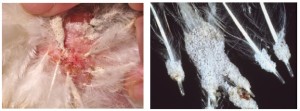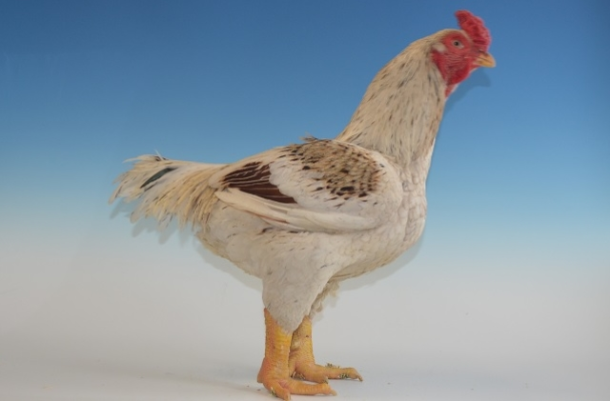Common Lice and Mites of Poultry: Identification and Treatment
BRIGID MCCREA, Post-Doctoral Employee, Department of Animal Science, UC Davis; JOAN S. JEFFREY, former Extension Poultry Veterinarian, University of California, Davis; RALPH A. ERNST, Extension Poultry Specialist Emeritus, UC Davis; and ALEC C. GERRY, Assistant Veterinary Entomologist and Extension Specialist, UC Riverside.
Lice and mites are common poultry pests. They feed on the blood, feathers, skin, or scales of the bird. Heavy infestations can result in poor poultry health, reduced growth and egg production, and even the death of birds. Correct identification of the specific louse or mite pest is important to selecting an appropriate treatment regimen.
COMMON POULTRY LICE
Lice are small (mostly between 1 and 6 mm [0.04 to 0.24 in] long), wingless, straw-colored insects with a somewhat flattened appearance and in most cases an elongated abdomen (the hindmost body segment). All poultry lice have chewing mouthparts and feed on dry skin scales, scab tissue, and feather parts. They also feed on blood when the host bird’s skin or feather quills are punctured. Lice are commonly found on both the skin and feathers and can move from one bird to another when birds are kept in close contact. The louse’s eggs (nits) usually are attached to the feathers.
Lice are ectoparasites and spend their entire life on an animal host. Most louse species are host specific, meaning that they can feed on only one or a few closely related species of animal hosts. Poultry lice cannot survive on humans or on our non-bird domestic pets. In fact, a poultry louse generally completes its entire life cycle from egg to adult on a single bird, and will die within a few days to a week if separated from a host. The number of lice on poultry tend to be greatest during the autumn and winter.
Lice are ectoparasites and spend their entire life on an animal host. Most louse species are host specific, meaning that they can feed on only one or a few closely related species of animal hosts. Poultry lice cannot survive on humans or on our non-bird domestic pets. In fact, a poultry louse generally completes its entire life cycle from egg to adult on a single bird, and will die within a few days to a week if separated from a host. The number of lice on poultry tend to be greatest during the autumn and winter.
Poultry lice are not known to transmit any avian pathogens, although some wild bird lice are suspected of transmitting pathogens to their hosts. The presence of lice frequently accompanies poor poultry health that is attributable to other causes, and is especially harmful to young birds where high numbers of lice may cause sleep disruption. Effective self-grooming of poultry is an important means of reducing lice. Louse populations are generally higher on birds with injured beaks or on those that have had their beaks trimmed. Molting greatly reduces louse populations, and one effective way to address a severe louse problem is to induce molting and then rapidly remove nit-laden feathers from the poultry facility.
The two most common louse species affecting California poultry are the chicken body louse (Menacanthus stramineus) and the shaft louse (Menapon gallinae). Adult chicken body lice measure 3 to 3.5 mm (0.12 to 0.14 in) long while adult shaft lice are about 2 mm (0.08 in) long. Adult chicken body lice are most prevalent around the sparsely feathered vent, breast, and thigh regions. Eggs of the chicken body louse are cemented in clusters to the base of feathers, especially around the vent, while eggs of the shaft louse are cemented individually at the base of the feather shaft or along the feather barb in the breast and thigh regions (Figures 1 and 2). Eggs of both species require 4 to 7 days to hatch and then 10 to 15 days to reach adulthood. An adult louse can lay from 50 to 300 eggs in its 3-week lifespan.
Birds should be checked for lice at least twice a month. Examination involves spreading the bird’s feathers in the vent, breast, and thigh regions to look for egg clusters or feeding adults at the base of the feathers. The presence of some lice on most birds or of egg clusters on one or more birds is enough to indicate the need for treatment. Chemical treatment, if required, should be applied at 10- to 14-day intervals until the lice and nit numbers fall below this level. Louse eggs are resistant to insecticides, so a single insecticide treatment may not be sufficient to provide control. Louse eggs will subsequently hatch when the insecticide is no longer active. By re-treating at 7- to 10-day intervals, you can kill the newly hatched generation that survived the previous chemical treatment before they can grow to adulthood and lay additional eggs.
COMMON POULTRY MITES
Mites, too, are very small (just visible without magnification) and may look like dark, moving specks. Like lice, mites are wingless, but in other aspects their body shape is quite different. Besides being much smaller, mites have a generally rounded body shape and lack any obvious body segmentation. Also, mites are arachnids, not insects, so an adult mite has eight legs while an adult louse (an insect) has only six. Mites are not as host specific as lice and may parasitize many animal species. Mites of some species spend their entire life on a single bird, while others are found on the bird only during active feeding periods and retreat to nearby protected locations after feeding. Like lice, mites generally increase in number during the winter months and decrease in the summer.
Chicken mite (or red poultry mite, Dermanyssus gallinae) is a blood-sucking mite that generally feeds on poultry during the night. During the day these mites may be hiding in areas throughout the poultry house, especially in cracks and crevices of surrounding woodwork, under clods of dirt or manure, or in nests. Their habit of leaving the host after night-time feeding is diagnostic for this mite species. Chicken mites can be red (following a blood meal) to black and can often be found clustered together in the environment surrounding the birds. Usually you have to inspect your birds at night to find them on the skin. Because they need to find daytime hiding places, chicken mites are not generally a pest in cage layer operations, but they can be quite problematic in breeder operations or other situations where fowl are maintained on litter or have nest boxes. Chicken mites have a broad host range and are often associated with a number of wild birds in addition to domestic poultry.

Figures 1 (left) and 2 (right). Egg clusters of the chicken body louse on base of vent feathers. Each egg is less than 1 mm long. Photos by Nancy Hinkle, University of Georgia (Figure 1) and Brad Mullens, UC Riverside (Figure 2).
